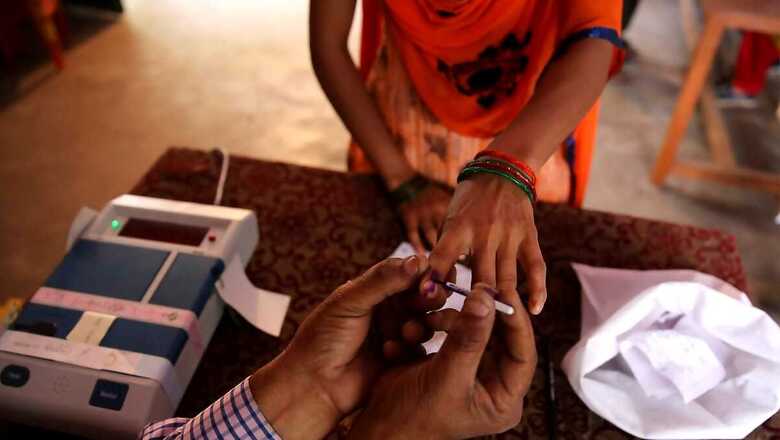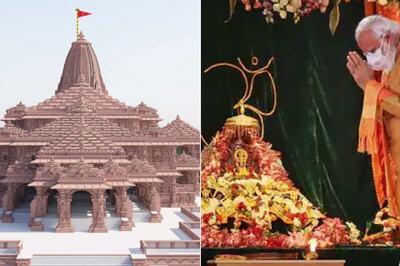
views
Pratapgarh is one of the 80 Lok Sabha constituencies in Uttar Pradesh and falls under the general category. It encompasses parts of the Pratapgarh district and comprises five assembly segments: Rampur Khas, Vishwanathganj, Pratapgarh, Patti, and Raniganj.
Sangam Lal Gupta is the Bharatiya Janata Party candidate and the incumbent MP here since 2019, preceded by Harivansh Singh Kumar of Apna Dal who won the polls in 2014, and Rajkumari Ratna Singh of the Congress in 2009. The other top contender this time for the election to be held on May 25 in the sixth phase of the ongoing Lok Sabha polls is Dr SP Singh Patel from the Samajwadi Party.
Political dynamics
Close Contest on the Cards: Pratapgarh is all set to witness a close contest with the Bharatiya Janata Party (BJP) and the Samajwadi Party (SP) locking horns in a direct fight. While the BJP has an edge here, the SP stands strong in the race as well.
In the 2022 assembly polls, the BJP bagged only one seat here, Pratapgarh, while the SP won Patti and Raniganj, Congress netted Rampur Khas, and Apna Dal (S) picked up Vishwanathganj. In terms of vote share, the SP scored 22%, up from 16.8% in the 2017 assembly elections. The BJP’s share also grew from 22% in 2017 to 32% in 2022.
This seat was traditionally a Congress stronghold, and after 1996, it swung consistently among the Congress, BJP, SP, and Apna Dal.
BJP on a Shaky Throne: The BJP sits on a shaky throne as it has renominated incumbent MP Sangam Lal Gupta to contest for a second term. Gupta won the election in 2019 on a BJP ticket by a margin of 1.17 lakh votes, defeating Bahujan Samaj Party candidate Ashok Tripathi who was backed by the SP. Gupta’s stock has dipped in the constituency over the years, with some voters alleging that he has not been accessible enough. Even among supporters, there was anticipation of a change in the BJP’s pick, but that has not been the case.
However, Gupta does have some development work to highlight in his campaign, including improved roads, a bypass road in the works which will alleviate traffic congestion, improvement of infrastructure at the railway station, and so on.
Gupta has the backing of the BJP’s grassroots worker machine, which has grown to a formidable size. Further, the party’s only MLA Rajendra Kumar from the Pratapgarh segment has thrown his weight behind the leader to ensure a BJP win.
The BJP is banking on the Narendra Modi factor, which is visible in its campaign efforts. Further, the promise of the Narendra Modi-Yogi Adityanath double-engine government has been marketed widely, with improvement in law and order, development and welfare schemes, all of which have noticeable effects. Hindutva and Ram Mandir politics are a plus point. Moreover, the government’s position on national issues also helps give it an edge among a large section of voters.
However, caste differences also play a big role in how locals decide to vote. While Brahmins and Kshatriyas are expected to vote for the BJP, along with a large portion of the Scheduled Caste voters as well, there is some dissatisfaction in other communities. In this constituency, Kurmi voters make up about 11% of the population and are a decisive factor. This time around, there is discontentment among Kurmi voters who in 2022 voted for candidates of their caste against the BJP. This is a worrying trend for the party as its opponent, the SP, has nominated Dr DP Singh Patel, who is from the Kurmi community.
The BJP also hopes that the BSP, which has chosen not to form an alliance with the SP this time, will do considerable damage to the SP’s performance. The BSP has picked BJP leader Shiv Prakash Mishra Senani’s son and Supreme Court lawyer Prathamesh Mishra, who will make his electoral debut. Further, Raghuraj Pratap Singh alias Raja Bhaiya’s Jansatta Dal (Loktantrik), another emerging player in the political scene, is sitting on the fence.
All in all, the BJP may witness a downward trend in its fortunes this election, but with a lead of 1.17 lakh votes in 2019, it has a considerable cushion against the Samajwadi threat.
INDIA Bloc’s Kurmi Candidate: The Samajwadi Party has always had it difficult in Pratapgarh, having won the seat only once in 2004. In alliance with the Congress, it has nominated Dr SP Singh Patel, who is from the Kurmi community. Although a “non-local” from Lucknow, Patel is a prominent educator in Uttar Pradesh, known for founding Lucknow Public Schools and Colleges, a prestigious institution in northern India. Patel served as a member of the legislative council for two consecutive terms. From 2014 to 2020, his wife Kanti Singh held the position of legislative council member from the same seat.
The party is hoping for a traditional consolidation of Yadav and Muslim votes, roughly 10% and 14%. This it expects to be bolstered by the support of Kurmi voters who may resonate with Patel, who is a well-known figure in the community. Moreover, the Congress also brings a large number of votes to the table, with the party scoring about 8.5%, coming in third in 2019.
Voter demographics (2011 Census)
- Total voters (2019): 1705457
- Urban: 5.7%
- Rural: 94.3%
- Literacy: 60.19%
- SC: 19.9%
- ST: 0%
- Hindu: ~85%
- Muslim: 14.1%
Key issues
Man vs Wild: There have been many instances of man-animal conflict in Pratapgarh. The issue is especially prevalent in rural areas where there is high forest cover. Villagers encounter wild animals such as leopards in their villages attacking cattle and humans alike. The expansion of human settlements into forest areas has deprived wild animals of their hunting grounds, forcing them to move into human settlements. In one such case, two people moving through the jungle areas towards the fields were attacked and killed late at night.
Traffic Congestion: Traffic congestion in Pratapgarh city has become a major nuisance for the residents. The city’s road infrastructure has been unable to keep up with the demands of the rising population. The city is littered with narrow lanes and encroachment of footpaths and sidewalks. This causes major traffic congestion in the city in key areas. The state government has taken aim at the challenge by upgrading the road infrastructure in the city and has given more power to the municipal corporation. However, the problem still persists.
Unemployment: Unemployment remains a big concern in the constituency. There are no major industries in the region. Agriculture is one of the key sources of employment. However, due to several issues, it is not a desirable option for many who are looking for better employment opportunities. This leads to mass migration of people, especially the youth towards urban centres in the state or to Maharashtra, Gujarat, and Delhi.
Farmer Issues: The lack of basic infrastructure in the region makes farming a difficult endeavour. Farmers face challenges from inadequate irrigation systems, and increasing costs of essential inputs like electricity, water, and fertilisers, which significantly impact their profitability. Small-scale farmers are particularly vulnerable, as they often lack the means to engage with complex government procurement procedures and are compelled to sell their produce to local traders at reduced prices. This practice leads to lower earnings, sometimes resulting in financial losses, and exacerbates their debt burden, especially for those who resort to high-interest loans from local moneylenders. To address these issues, farmers advocate for higher minimum support prices for their crops and demand prompt compensation in the event of crop failures, aiming to reduce their financial strain. Indian Gooseberry (amla) is the staple produce in the region. However, its cultivation is no longer profitable. The number of farmers engaged in growing the fruit has halved and the area under cultivation has also shrunk. The amla crop was grown on around 10,800 hectares, which has now shrunk to less than 6,000 hectares.
Welfare Schemes: Welfare schemes by the state and central governments will be a major factor in this Lok Sabha constituency. In Pratapgarh alone, the government has provided 10,145 houses in urban areas and has given interest-free loans to 4,595 street vendors under the PM SVANidhi Yojana. Besides, 14,600 destitute, 11,500 elderly and old people are getting pensions. This has made the people flock in support of the BJP. However, other initiatives such as the Jal Jeevan Scheme have not been implemented fully, which has deprived people of their promised piped water connection.
Law and Order: The law-and-order situation in the region has improved considerably. According to ground reports, crime in the region has been considerably down over the past five years. The situation was considerably grim in 2019. However, people now feel more secure as there have been significant civic infrastructure upgrades such as the installation of streetlights, etc. Locals also believe that the ongoing crackdown on criminal elements across the state by the government has also been effective in Pratapgarh.
Infrastructure development
Amrit Bharat: Pratapgarh Junction is one of the major nodal points of the North Central Railway. As a result, it has also been selected as part of the central government’s Amrit Bharat Station scheme. It will give the junction a much-needed infrastructure overhaul and improve passenger amenities.
Widening of National Highway 330: The project was announced by union minister Nitin Gadkari last year. It is a widening of a 43-km stretch of NH-330 from Pratapgarh to Sultanpur, which will be done at a cost of Rs 1,290 crore. This will reduce the travel time from Prayagraj to Pratapgarh via Ayodhya.
Bypass in Pratapgarh: A 14-km bypass project is under construction in Pratapgarh, which will help vehicles plying on the national highway to avoid the heavily congested city area. It is being constructed at a cost of Rs 309 crore.
Other NH Projects: Several other road connectivity projects are under construction in Pratapgarh. Among these are the 21-km-long Chilbila-Lohia Nagar two-lane paved shoulder road for Rs 333 crore, an 11-km-long four-lane CC road on Bhupiyamau-Gode section in Pratapgarh town at a cost of Rs 325 crore, a two-lane paved shoulder bypass from NH-31 to NH-330 of Pratapgarh for Rs 225 crore, and streetlight, high mast light, and development of shelters in Pratapgarh district at Rs 27 crore.
Railway Infrastructure: A submersible pump was installed for a deep tube well at Pratapgarh station, and a road over bridge was built near Chilbila at level crossing 84-B. Several manned level crossings were replaced with limited-height subways on the Harpalganj-Koipur and Suwansa-Gaura sections. Pratapgarh station itself received a number of upgrades, including renovated waiting areas, improvements to platform 1, a new VIP lounge, and a passenger reservation system building. The station also benefited from better lighting, with the installation of LED lights on the platform and 45W LED streetlights throughout the station.
Explore in-depth coverage of Lok Sabha Election 2024 Schedule, Voter Turnout, Upcoming Phase And Much More At News18 Website




















Comments
0 comment